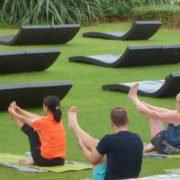5 Intention-setting Ideas to Spread Kindness
Valentine’s Day is a reminder to share the love!
This “Hallmark Holiday” doesn’t have to have the market corned on romantic love. We can challenge the world to broaden the view of February 14th as a reminder to share the love and kindness with ourselves and others.
Below are some intention setting ideas to spread kindness and, by doing so, bring more peace and joy into our hearts and into the world:
- Write a note. When was the last time you received a hand-written note expressing sentiments from the heart? Can you remember what it felt like? Take a moment now and bring to mind someone in your life (past or present) that meant a lot to you, perhaps because they took care of you in a time of need or maybe because they had your back during a difficult time in your life. Consider writing them a note expressing what their kindness and thoughtfulness meant to you. It is never too late to share the impact people have had on our lives, even if they have transitioned from this life. Once the note is written, if possible mail it. If not, light a candle, sit with the light of the candle visualizing the person (maybe you have a picture you can look at) and read them your note. Trust the energy and love behind your words will reach them. Take a moment to tune into your heart, noting any sensations present. Often, the sensations are the human experience of love and kindness being shared!
- Say ‘thank you’ more. These two simple words have a powerful effect! Practice saying ‘thank you’ to yourself, when you make a decision that serves you well or when you remember to use one of your self-care tools in your tool box. As you practice, again tune into your heart center and sense the response. If you find this practice a little challenging, try saying ‘thank you’ to another, maybe your mail delivery person, the cashier at the supermarket, a co-worker or your child. Like anything else, the more you practice, the easier it gets. Don’t forget to come back around and thank yourself!
- HUG more! Research suggests giving and receiving hugs has a positive impact on your body and mind health. If this gesture of care, kindness and appreciation is not currently one of the tools in your self-care tool kit, no worries. You can simply start by hugging aspects of Mother Nature, such as trees (yes, trees!) and animals. Children also love to receive – and give – hugs. You can also give yourself a hug, especially when life throws you a curve ball. As you begin to embrace (pun intended!) this practice, if you are inspired to hug someone, make sure to ask permission first no matter their age, especially if it someone that you are just getting to know better!
- Take a walk & pick up litter. Speaking of Mother Nature, it is important to share our kindness and love with her as well. The next time you plan to take a walk, whether around the block or a 10-mile hike, bring a trash bag with you and pick up any litter you might come across in your travels. As you do so, thank Mother Earth for all that she provides us, including the air we breathe, the water we drink, and the food we eat. She also provides for the materials utilized to build our shelters, so she has a significant and vital part in our lives.
- Write a kind story about yourself. Start by listing 3-5 aspects of yourself that you like or appreciate. It might be good qualities that you sometimes display, such as patience or generosity, or values that are important to you, such as beauty or connection. Now, write a story with you as the central figure, including these good qualities (and any more that might rise into awareness as you are writing). The story can be drawn from past memories of times when you allowed these good qualities to be seen by the world or the story might be written about how you might let these qualities come forward more in the future. Remember, if any uncomfortable feelings arise as you are writing, you can step into the role of a compassionate friend and let them finish writing it for you.
As always, if you try any of these intention-setting ideas for holistic health, I would love to hear about the impact they might have had for you. Please send me an email at linda@sanctuary4compassion.com to share!











